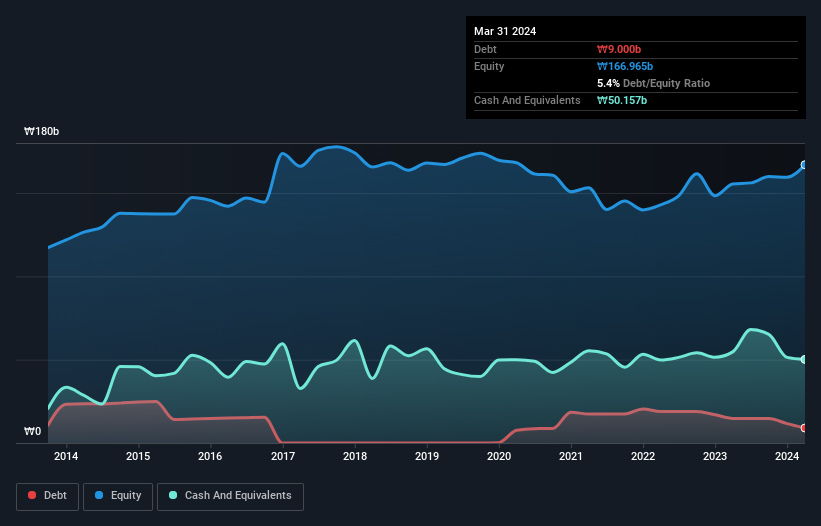- South Korea
- /
- Electronic Equipment and Components
- /
- KOSDAQ:A049520
Is UIL (KOSDAQ:049520) Using Too Much Debt?
The external fund manager backed by Berkshire Hathaway's Charlie Munger, Li Lu, makes no bones about it when he says 'The biggest investment risk is not the volatility of prices, but whether you will suffer a permanent loss of capital.' When we think about how risky a company is, we always like to look at its use of debt, since debt overload can lead to ruin. Importantly, UIL Co., Ltd. (KOSDAQ:049520) does carry debt. But the real question is whether this debt is making the company risky.
What Risk Does Debt Bring?
Debt is a tool to help businesses grow, but if a business is incapable of paying off its lenders, then it exists at their mercy. Part and parcel of capitalism is the process of 'creative destruction' where failed businesses are mercilessly liquidated by their bankers. While that is not too common, we often do see indebted companies permanently diluting shareholders because lenders force them to raise capital at a distressed price. Of course, debt can be an important tool in businesses, particularly capital heavy businesses. The first step when considering a company's debt levels is to consider its cash and debt together.
See our latest analysis for UIL
How Much Debt Does UIL Carry?
As you can see below, UIL had ₩9.00b of debt at March 2024, down from ₩14.8b a year prior. But on the other hand it also has ₩50.2b in cash, leading to a ₩41.2b net cash position.

A Look At UIL's Liabilities
Zooming in on the latest balance sheet data, we can see that UIL had liabilities of ₩74.0b due within 12 months and liabilities of ₩9.74b due beyond that. Offsetting this, it had ₩50.2b in cash and ₩65.0b in receivables that were due within 12 months. So it can boast ₩31.4b more liquid assets than total liabilities.
This excess liquidity suggests that UIL is taking a careful approach to debt. Because it has plenty of assets, it is unlikely to have trouble with its lenders. Succinctly put, UIL boasts net cash, so it's fair to say it does not have a heavy debt load!
In addition to that, we're happy to report that UIL has boosted its EBIT by 91%, thus reducing the spectre of future debt repayments. When analysing debt levels, the balance sheet is the obvious place to start. But it is UIL's earnings that will influence how the balance sheet holds up in the future. So if you're keen to discover more about its earnings, it might be worth checking out this graph of its long term earnings trend.
Finally, a business needs free cash flow to pay off debt; accounting profits just don't cut it. UIL may have net cash on the balance sheet, but it is still interesting to look at how well the business converts its earnings before interest and tax (EBIT) to free cash flow, because that will influence both its need for, and its capacity to manage debt. Looking at the most recent two years, UIL recorded free cash flow of 44% of its EBIT, which is weaker than we'd expect. That's not great, when it comes to paying down debt.
Summing Up
While we empathize with investors who find debt concerning, you should keep in mind that UIL has net cash of ₩41.2b, as well as more liquid assets than liabilities. And it impressed us with its EBIT growth of 91% over the last year. So we don't think UIL's use of debt is risky. Above most other metrics, we think its important to track how fast earnings per share is growing, if at all. If you've also come to that realization, you're in luck, because today you can view this interactive graph of UIL's earnings per share history for free.
If you're interested in investing in businesses that can grow profits without the burden of debt, then check out this free list of growing businesses that have net cash on the balance sheet.
New: AI Stock Screener & Alerts
Our new AI Stock Screener scans the market every day to uncover opportunities.
• Dividend Powerhouses (3%+ Yield)
• Undervalued Small Caps with Insider Buying
• High growth Tech and AI Companies
Or build your own from over 50 metrics.
Have feedback on this article? Concerned about the content? Get in touch with us directly. Alternatively, email editorial-team (at) simplywallst.com.
This article by Simply Wall St is general in nature. We provide commentary based on historical data and analyst forecasts only using an unbiased methodology and our articles are not intended to be financial advice. It does not constitute a recommendation to buy or sell any stock, and does not take account of your objectives, or your financial situation. We aim to bring you long-term focused analysis driven by fundamental data. Note that our analysis may not factor in the latest price-sensitive company announcements or qualitative material. Simply Wall St has no position in any stocks mentioned.
Have feedback on this article? Concerned about the content? Get in touch with us directly. Alternatively, email editorial-team@simplywallst.com
About KOSDAQ:A049520
UIL
Manufactures and sells electronic parts to smartphone manufacturers in South Korea and internationally.
Flawless balance sheet, good value and pays a dividend.
Market Insights
Community Narratives



